RCAF History Forum
Moderators: lilfssister, North Shore, sky's the limit, sepia, Sulako, I WAS Birddog
- YYZSaabGuy
- Rank 8

- Posts: 851
- Joined: Wed Aug 04, 2010 7:32 am
- Location: On glideslope.
Re: RCAF History Forum
So it's gotta be Cormorant, Lake Manitoba (N54, 14 W100, 36 per my CFS).Moose47 wrote:G'day
Today's hint - Phalacrocorax
Cheers...Chris
-
iflyforpie
- Top Poster

- Posts: 8132
- Joined: Tue Apr 15, 2008 12:25 pm
- Location: Winterfell...
Re: RCAF History Forum
I haven't seen it anywhere on here so I am sorry if it has been posted already, but there is a really neat film on the National Film Board's website called Canada's Air Defence. It's a really cool vignette of what the RCAF was in the 1950s from the perspective of a CF-100 crew.
http://www.nfb.ca/film/canadas_air_defence/
http://www.nfb.ca/film/canadas_air_defence/
- YYZSaabGuy
- Rank 8

- Posts: 851
- Joined: Wed Aug 04, 2010 7:32 am
- Location: On glideslope.
Re: RCAF History Forum
Good find, IF - I enjoyed that one. Thanks for posting it.iflyforpie wrote:I haven't seen it anywhere on here so I am sorry if it has been posted already, but there is a really neat film on the National Film Board's website called Canada's Air Defence. It's a really cool vignette of what the RCAF was in the 1950s from the perspective of a CF-100 crew. http://www.nfb.ca/film/canadas_air_defence/
-
Moose47
- Rank (9)

- Posts: 1348
- Joined: Sat Apr 19, 2008 2:45 pm
- Location: Home of Canada's Air Defence
Re: RCAF History Forum
G'day Rolph
You get a free fish for getting the right answer.
Bon Apetit!
Cheers...Chris
You get a free fish for getting the right answer.
Bon Apetit!
Cheers...Chris
-
Moose47
- Rank (9)

- Posts: 1348
- Joined: Sat Apr 19, 2008 2:45 pm
- Location: Home of Canada's Air Defence
Re: RCAF History Forum
G'day Pie
I have seen that film before. Thanx for posting it.
I'll be making you a coconut creme pie this afternoon. You can fly in anytime after 17:00 today to pick it up.
Cheers...Chris
I have seen that film before. Thanx for posting it.
I'll be making you a coconut creme pie this afternoon. You can fly in anytime after 17:00 today to pick it up.
Cheers...Chris
-
Moose47
- Rank (9)

- Posts: 1348
- Joined: Sat Apr 19, 2008 2:45 pm
- Location: Home of Canada's Air Defence
Re: RCAF History Forum
G`day
In the mid-1950's, the R.C.A.F. conducted a series of tests on this Otter fitted with retractable landing gear. It was hoped that it would help increase the airspeed by as much as 10 knots. After four incidents of gear failure, engineers proclaimed the test program a dismal failure and further development plans were shelved. Just kidding!
Here we have a de Havilland of Canada Limited DHC-3 Otter, s/n 3672 and coded MN*672 from R.C.A.F. Station Rockcliffe, Ontario-based No. 408 'Goose' (P) Squadron. It was accepted into service on the 11th of December, 1953 by the R.C.A.F.`s No. 12 Technical Services Unit located at the de Havilland`s plant in Downsview, Ontario. The aircraft sustained Category 'A' damage after a rather hard landing at R.C.A.F. Unit Fort Churchill, Manitoba on the 26th of April, 1954. On the 19th of May, 1954, authorization was given to write-off Otter 3672 and have it reduced to spares and produce.
No. 408 'Goose' (P) Squadron used the Otter in support of photographic operations from February, 1953 to September, 1957. As well as providing logistical support, Otters were used to fly in maintenance personnel to ground based stations affilaited with the short range navigation system (SHORAN) The SHORAN stations were used for geodetic control in aerial phtography in Canada's far north and arctic regions flown by the squadron's Avro Lancasters.
Cheers...Chris
In the mid-1950's, the R.C.A.F. conducted a series of tests on this Otter fitted with retractable landing gear. It was hoped that it would help increase the airspeed by as much as 10 knots. After four incidents of gear failure, engineers proclaimed the test program a dismal failure and further development plans were shelved. Just kidding!
Here we have a de Havilland of Canada Limited DHC-3 Otter, s/n 3672 and coded MN*672 from R.C.A.F. Station Rockcliffe, Ontario-based No. 408 'Goose' (P) Squadron. It was accepted into service on the 11th of December, 1953 by the R.C.A.F.`s No. 12 Technical Services Unit located at the de Havilland`s plant in Downsview, Ontario. The aircraft sustained Category 'A' damage after a rather hard landing at R.C.A.F. Unit Fort Churchill, Manitoba on the 26th of April, 1954. On the 19th of May, 1954, authorization was given to write-off Otter 3672 and have it reduced to spares and produce.
No. 408 'Goose' (P) Squadron used the Otter in support of photographic operations from February, 1953 to September, 1957. As well as providing logistical support, Otters were used to fly in maintenance personnel to ground based stations affilaited with the short range navigation system (SHORAN) The SHORAN stations were used for geodetic control in aerial phtography in Canada's far north and arctic regions flown by the squadron's Avro Lancasters.
Cheers...Chris
- Attachments
-
- Otteruc.jpg (28.81 KiB) Viewed 8141 times
-
Moose47
- Rank (9)

- Posts: 1348
- Joined: Sat Apr 19, 2008 2:45 pm
- Location: Home of Canada's Air Defence
Re: RCAF History Forum
G'day
This is a Douglas DB-1 Digby, s/n 740 and coded PB-L
It was taken on strength with the R.C.A.F. at Ottawa, Ontario on the 30th of December, 1939, It spent a short time at R.C.A.F. Station Trenton prior to being transferred to Eastern Air Command's No. 10 (BR) Squadron at R.C.A.F. Station Dartmouth, Nova Scotia on the 17th of June, 1940. The squadron`s un-official title was 'North Atlantic Squadron' and its nickname 'Dumbo'.
Eastern Air Command's first attack against a German U-Boat took place on the 25th of October, 1941. Digby 740 flown by C196 Squadron Leader Clare Levi Annis from Highland Creek, Ontario, who was also E.A.C.`s armament officer, Annis and his crew dropped a pair of 600 pound depth charges over the U-Boat but unfortunately they did not explode. This attack was also the first against the enemy by a North American based aircraft. Annis would go on to command the squadron not once but twice during the war.
No. 10 (BR) Squadron provided a detachment of three Digbys with crews including 740 with No. 164 Transport Squadron`s formation at R.C.A.F. Station Moncton, New Brunswick. The detachment lasted from the 24th of January to the 22nd of March, 1943.
The Digbys were withdrawn from service with No. 10 (BR) Squadron in April, 1943. They were replaced by the Consolidated Liberator. In May, 1943, Digby 740 was transferred to Eastern Air Command`s No. 167 (Communications) Squadron. The squadron was based at R.C.A.F. Station Dartmouth, Nova Scotia.
Digby 740 was transferred to No. 4 Repair Depot at R.C.A.F. Station Dartmout, Nova Scotia on the 18th of November, 1943. It was immediately put in to War Reserve. Digby 740 was time expired and as a result, written off on the 16th of May, 1944 reduced to spares and produce.
Cheers...Chris
This is a Douglas DB-1 Digby, s/n 740 and coded PB-L
It was taken on strength with the R.C.A.F. at Ottawa, Ontario on the 30th of December, 1939, It spent a short time at R.C.A.F. Station Trenton prior to being transferred to Eastern Air Command's No. 10 (BR) Squadron at R.C.A.F. Station Dartmouth, Nova Scotia on the 17th of June, 1940. The squadron`s un-official title was 'North Atlantic Squadron' and its nickname 'Dumbo'.
Eastern Air Command's first attack against a German U-Boat took place on the 25th of October, 1941. Digby 740 flown by C196 Squadron Leader Clare Levi Annis from Highland Creek, Ontario, who was also E.A.C.`s armament officer, Annis and his crew dropped a pair of 600 pound depth charges over the U-Boat but unfortunately they did not explode. This attack was also the first against the enemy by a North American based aircraft. Annis would go on to command the squadron not once but twice during the war.
No. 10 (BR) Squadron provided a detachment of three Digbys with crews including 740 with No. 164 Transport Squadron`s formation at R.C.A.F. Station Moncton, New Brunswick. The detachment lasted from the 24th of January to the 22nd of March, 1943.
The Digbys were withdrawn from service with No. 10 (BR) Squadron in April, 1943. They were replaced by the Consolidated Liberator. In May, 1943, Digby 740 was transferred to Eastern Air Command`s No. 167 (Communications) Squadron. The squadron was based at R.C.A.F. Station Dartmouth, Nova Scotia.
Digby 740 was transferred to No. 4 Repair Depot at R.C.A.F. Station Dartmout, Nova Scotia on the 18th of November, 1943. It was immediately put in to War Reserve. Digby 740 was time expired and as a result, written off on the 16th of May, 1944 reduced to spares and produce.
Cheers...Chris
- Attachments
-
- Digby740.jpg (33.46 KiB) Viewed 8037 times
-
Moose47
- Rank (9)

- Posts: 1348
- Joined: Sat Apr 19, 2008 2:45 pm
- Location: Home of Canada's Air Defence
Re: RCAF History Forum
G'day
This photo shows a Noorduyn Norseman Mk. IV, s/n 366 and coded AP*V from No. 413 'Tusker`(ST) Squadron. This survey and transport squadron was part of Air transport Command`s No. 22 (Photographic) Wing and based at R.C.A.F. Station Rockcliffe, Ontario. The Norsemans were used by the squadron to provide logistical support and light transport for survey teams in Canada`s far north from April, 1947 to October, 1950.
R.C.A.F. Norseman 366 was a Lend-Lease aircraft. It was originally U.S.A.A.F. s/n 43-5284 and designated as a UC-64. This Norseman was taken on strength with the R.C.A.F. on the 6th of December, 1943 where it served with Western Air Command`s Northwest Staging Route Communications Flight based at R.C.A.F. Station Edmonton, Alberta. It sustained Category 'C' damage at Edmonton on the 9th of June 1944 while with No. 6 Communications Flight. It later served with the Station Flight at R.C.A.F. Station Edmonton Norseman 366 was transferred to Transport Command`s No. 413 'Tusker' (ST) Squadron on the 13th of April, 1948. During its time with the squadron, it took part in No. 10 Geodetic Survey Detachment in the Northwest Territories and the Yukon Territory.
Norseman 366 was then transferred to No. 408 'Goose' (P) Squadron at R.C.A.F. Station Rockcliffe, Ontario on the 1st of May, 1951. It was coded AK*T. On the 9th of June, 1953 it was transferred to No. 111 Communications & Rescue Flight at R.C.A.F. Station Winnipeg, Manitoba
On the 16th of December, 1953, the aircraft was put into storage at R.C.A.F. Station Lincoln Park , Calgary, Alberta.. It was sold to Noorduyn Aviation Limited on the 25th of November, 1955. In 1956, it was sold to Canadian Structural Steel Works and registered as CF-INL.
Cheers...Chris
This photo shows a Noorduyn Norseman Mk. IV, s/n 366 and coded AP*V from No. 413 'Tusker`(ST) Squadron. This survey and transport squadron was part of Air transport Command`s No. 22 (Photographic) Wing and based at R.C.A.F. Station Rockcliffe, Ontario. The Norsemans were used by the squadron to provide logistical support and light transport for survey teams in Canada`s far north from April, 1947 to October, 1950.
R.C.A.F. Norseman 366 was a Lend-Lease aircraft. It was originally U.S.A.A.F. s/n 43-5284 and designated as a UC-64. This Norseman was taken on strength with the R.C.A.F. on the 6th of December, 1943 where it served with Western Air Command`s Northwest Staging Route Communications Flight based at R.C.A.F. Station Edmonton, Alberta. It sustained Category 'C' damage at Edmonton on the 9th of June 1944 while with No. 6 Communications Flight. It later served with the Station Flight at R.C.A.F. Station Edmonton Norseman 366 was transferred to Transport Command`s No. 413 'Tusker' (ST) Squadron on the 13th of April, 1948. During its time with the squadron, it took part in No. 10 Geodetic Survey Detachment in the Northwest Territories and the Yukon Territory.
Norseman 366 was then transferred to No. 408 'Goose' (P) Squadron at R.C.A.F. Station Rockcliffe, Ontario on the 1st of May, 1951. It was coded AK*T. On the 9th of June, 1953 it was transferred to No. 111 Communications & Rescue Flight at R.C.A.F. Station Winnipeg, Manitoba
On the 16th of December, 1953, the aircraft was put into storage at R.C.A.F. Station Lincoln Park , Calgary, Alberta.. It was sold to Noorduyn Aviation Limited on the 25th of November, 1955. In 1956, it was sold to Canadian Structural Steel Works and registered as CF-INL.
Cheers...Chris
- Attachments
-
- 413Norseman.jpg (75.73 KiB) Viewed 7981 times
-
linecrew
- Rank (9)

- Posts: 1900
- Joined: Fri Feb 20, 2004 6:53 am
- Location: On final so get off the damn runway!
Re: RCAF History Forum
Neat. I was curious about where RCAF station Lincoln Park used to be in Calgary and after a brief Google Earth search I found it. The old hangar line is still visible at N51 00' 52.91 W114 07 31.90. Mount Royal University is located on what used to be the airfield.
-
linecrew
- Rank (9)

- Posts: 1900
- Joined: Fri Feb 20, 2004 6:53 am
- Location: On final so get off the damn runway!
Re: RCAF History Forum
I guess this now qualifies as RCAF history. Two CP-140 Arcturus are now sitting in the Arizona desert having been withdrawn from use in 2011.
http://www.flickr.com/photos/shanair/61 ... otostream/
http://www.flickr.com/photos/shanair/61 ... otostream/
-
Moose47
- Rank (9)

- Posts: 1348
- Joined: Sat Apr 19, 2008 2:45 pm
- Location: Home of Canada's Air Defence
Re: RCAF History Forum
G'day
The R.C.A.F.`s No. 426 `Thunderbird' (T) Squadron took part in the Korean Airlift known as 'Operation Hawk' from July, 1950 to June, 1954. The squadron was based at McChord Air Force Base located eight miles south of Tacoma, Washington between the 25th of July, 1950 and 15th of June, 1954. Canadair North Stars of the squadron carried out 600 return flights across the North Pacific between Vancouver, British Columbia and Tokyo, Japan (Haneda Air Base). This amounted to 34,000 flying hours. The 'Thunderbirds' carried 13,000 personnel and 7 million pounds of freight and mail. There were no personnel lost and one aircraft written off in Shemya, Alaska
The North Star was faster than the U.S.A.F.'s Douglas C-54 Skymaster and was often tasked with medical evacuation from Japan back to the United States. A dear friend of mine, a crusty old Scot by the name of Tommy Bryant, told me many years ago about overhearing two young American airmen comment about the North Star while he was on temporary duty at Haneda Air Base. One of them got excited and said "look at that funny Charlie 54 with the Allisons!"
Cheers...Chris
The R.C.A.F.`s No. 426 `Thunderbird' (T) Squadron took part in the Korean Airlift known as 'Operation Hawk' from July, 1950 to June, 1954. The squadron was based at McChord Air Force Base located eight miles south of Tacoma, Washington between the 25th of July, 1950 and 15th of June, 1954. Canadair North Stars of the squadron carried out 600 return flights across the North Pacific between Vancouver, British Columbia and Tokyo, Japan (Haneda Air Base). This amounted to 34,000 flying hours. The 'Thunderbirds' carried 13,000 personnel and 7 million pounds of freight and mail. There were no personnel lost and one aircraft written off in Shemya, Alaska
The North Star was faster than the U.S.A.F.'s Douglas C-54 Skymaster and was often tasked with medical evacuation from Japan back to the United States. A dear friend of mine, a crusty old Scot by the name of Tommy Bryant, told me many years ago about overhearing two young American airmen comment about the North Star while he was on temporary duty at Haneda Air Base. One of them got excited and said "look at that funny Charlie 54 with the Allisons!"
Cheers...Chris
- Attachments
-
- Thunderbird.jpg (92.05 KiB) Viewed 8170 times
-
Moose47
- Rank (9)

- Posts: 1348
- Joined: Sat Apr 19, 2008 2:45 pm
- Location: Home of Canada's Air Defence
Re: RCAF History Forum
G'day
"Happy Birthday Royal Canadian Air Force!"
Royal Approval
By the 1st of April, 1924 the restructuring of the Canadian Air Force was completed. It was now time to turn a new page in Air Force history with the addition of the prefix 'Royal' to its name. The honour had been authorized by King George V on the 15th of February 1923. The word Royal started to show up in Air Force Orders by the 13th of March and on the following day appeared on all official correspondence henceforth. The prefix was not officially approved by the Canadian government until the 1st of April 1924 when at that time the King's Regulations and Orders for the Royal Canadian Air Force were implemented.
Aircraft Serving With The Royal Canadian Air Force as of the 1st of April 1924
Curtiss HS-2L
de Havilland D.H.4
de Havilland D.H.9
Vickers Viking Mk. IV
S.E. 5a
Avro 504K
Cheers...Chris
"Happy Birthday Royal Canadian Air Force!"
Royal Approval
By the 1st of April, 1924 the restructuring of the Canadian Air Force was completed. It was now time to turn a new page in Air Force history with the addition of the prefix 'Royal' to its name. The honour had been authorized by King George V on the 15th of February 1923. The word Royal started to show up in Air Force Orders by the 13th of March and on the following day appeared on all official correspondence henceforth. The prefix was not officially approved by the Canadian government until the 1st of April 1924 when at that time the King's Regulations and Orders for the Royal Canadian Air Force were implemented.
Aircraft Serving With The Royal Canadian Air Force as of the 1st of April 1924
Curtiss HS-2L
de Havilland D.H.4
de Havilland D.H.9
Vickers Viking Mk. IV
S.E. 5a
Avro 504K
Cheers...Chris
-
Moose47
- Rank (9)

- Posts: 1348
- Joined: Sat Apr 19, 2008 2:45 pm
- Location: Home of Canada's Air Defence
Re: RCAF History Forum
G'day
Aircraft Taken On Strength by Date, Type and Numbers
24th- 1941 Airspeed A.S. 10 Oxford Mk.'s 1/11 - 606
7th - 1930 Avro 616 Avian Mk. IVM Major - 18
27th - 1942 Avro 652A Anson Mk. I - 2
25th - 1952 Bristol Type 170 Freighter Mk.31C - 3
25th - 1956 Bristol Type 170 Freighter Mk. 31 - 1
19th - 1960 Canadair CC-109 Cosmopolitan - 10
26th - 1927 Vickers Vanessa - 1
11th - 1928 Vickers Vigil - 1
20th - 1942 Cessna T-50 Crane Mk. I - 82
13th - 1965 Cessna L182E - 4
18th - 1963 Cessna 182F - 2
15th - 1943 Consolidated Model 32 Liberator Mk.'s 111/IV - 22
10th - 1942 Curtiss Model 87 Kittyhawk Mk. IA - 12
10th - 1940 de Havilland D.H.82C Tiger Moth - 1,384
23rd - 1943 de Havilland D.H.98 Mosquito T. Mk. III - 24
29th - 1953 de Havilland D.H.106 Comet Mk. IA - 2
1st - 1948 de Havilland Canada D.H.C. 1A-1 Chipmunk - 1
23rd - 1964 de Havilland Canada CC-108 Caribou Mk. 1B - 4
16th - 1943 Douglas DB-7 Boston Mk. IIA - 1
30th - 1929 Fairchild 71- 11
12th - 1929 Fairchild Super Universal - 1
24th - 1944 Grumman G-21A Goose Mk. I - 2
7th - 1943 Lockheed-Vega V-146 Ventura G.R. Mk. V - 137
17th - 1940 North American NA-61 Harvard Mk. I - 3
9th - 1941 North American NA-81 Harvard Mk. II - 101
3rd - 1928 Pitcairn Model PA-5 Mailwing - 1
5th - 1947 Siskorsky H-5 - 7
Aircraft Struck Off Strength – By Date and Type
26th - 1944 - Airspeed A.S. 10 Oxford Mk. I
26th - 1944 - Avro 652A Anson Mk. I
7th - 1945 - Beechcraft 18D
30th - 1962 - Bell H-13B
16th - 1941 - Consolidated 0-17 Courier Mk. VII
26th - 1962 - Consolidated Model 28 Canso A
18th - 1947 - Consolidated Model 32 Liberator B. Mk. VI
27th - 1954 - Curtiss-Reid Rambler Mk. I
17th - 1948 - de Havilland D.H.98 Mosquito T. Mk. 27
13th - 1942 - Fairchild Super 71P
21st - 1942 - Grumman G-23 Goblin
18th - 1947 - Lockheed-Vega V-146 Ventura G.R. Mk. V
23rd - 1947 - Lockheed-Vega V-146 Ventura Mk. I
11th - 1949 - North American AT-16 Harvard Mk. IIB
5th - 1965 - Sikorsky H-5
21st - 1965 - Sikorsky H-19
24th - 1943 - Stearman Model D-75N1
25th - 1946 - Westland Lysander Mk. III T.T.
Cheers...Chris
Aircraft Taken On Strength by Date, Type and Numbers
24th- 1941 Airspeed A.S. 10 Oxford Mk.'s 1/11 - 606
7th - 1930 Avro 616 Avian Mk. IVM Major - 18
27th - 1942 Avro 652A Anson Mk. I - 2
25th - 1952 Bristol Type 170 Freighter Mk.31C - 3
25th - 1956 Bristol Type 170 Freighter Mk. 31 - 1
19th - 1960 Canadair CC-109 Cosmopolitan - 10
26th - 1927 Vickers Vanessa - 1
11th - 1928 Vickers Vigil - 1
20th - 1942 Cessna T-50 Crane Mk. I - 82
13th - 1965 Cessna L182E - 4
18th - 1963 Cessna 182F - 2
15th - 1943 Consolidated Model 32 Liberator Mk.'s 111/IV - 22
10th - 1942 Curtiss Model 87 Kittyhawk Mk. IA - 12
10th - 1940 de Havilland D.H.82C Tiger Moth - 1,384
23rd - 1943 de Havilland D.H.98 Mosquito T. Mk. III - 24
29th - 1953 de Havilland D.H.106 Comet Mk. IA - 2
1st - 1948 de Havilland Canada D.H.C. 1A-1 Chipmunk - 1
23rd - 1964 de Havilland Canada CC-108 Caribou Mk. 1B - 4
16th - 1943 Douglas DB-7 Boston Mk. IIA - 1
30th - 1929 Fairchild 71- 11
12th - 1929 Fairchild Super Universal - 1
24th - 1944 Grumman G-21A Goose Mk. I - 2
7th - 1943 Lockheed-Vega V-146 Ventura G.R. Mk. V - 137
17th - 1940 North American NA-61 Harvard Mk. I - 3
9th - 1941 North American NA-81 Harvard Mk. II - 101
3rd - 1928 Pitcairn Model PA-5 Mailwing - 1
5th - 1947 Siskorsky H-5 - 7
Aircraft Struck Off Strength – By Date and Type
26th - 1944 - Airspeed A.S. 10 Oxford Mk. I
26th - 1944 - Avro 652A Anson Mk. I
7th - 1945 - Beechcraft 18D
30th - 1962 - Bell H-13B
16th - 1941 - Consolidated 0-17 Courier Mk. VII
26th - 1962 - Consolidated Model 28 Canso A
18th - 1947 - Consolidated Model 32 Liberator B. Mk. VI
27th - 1954 - Curtiss-Reid Rambler Mk. I
17th - 1948 - de Havilland D.H.98 Mosquito T. Mk. 27
13th - 1942 - Fairchild Super 71P
21st - 1942 - Grumman G-23 Goblin
18th - 1947 - Lockheed-Vega V-146 Ventura G.R. Mk. V
23rd - 1947 - Lockheed-Vega V-146 Ventura Mk. I
11th - 1949 - North American AT-16 Harvard Mk. IIB
5th - 1965 - Sikorsky H-5
21st - 1965 - Sikorsky H-19
24th - 1943 - Stearman Model D-75N1
25th - 1946 - Westland Lysander Mk. III T.T.
Cheers...Chris
-
Old Dog Flying
- Rank (9)

- Posts: 1259
- Joined: Sun Jul 27, 2008 5:18 pm
Re: RCAF History Forum
A good many of these types can be seen in miniature at http://www.barneysairforce.com
-
Moose47
- Rank (9)

- Posts: 1348
- Joined: Sat Apr 19, 2008 2:45 pm
- Location: Home of Canada's Air Defence
Re: RCAF History Forum
G'day
Forgot to post this yesterday.
Cheers...Chris
New Formations
No. 1 (Operations) Wing
It was formed at Winnipeg, Manitoba on the 1st of April, 1925 under the command of Squadron Leader G. O. Johnson MC1. The Wing operated a wide variety of aircraft including the Vickers Viking, Canadian Vickers Vedette Mk. I and Canadian Vickers Varuna Mk. I.
No. 1 (Operations) Squadron
Squadron Leader A. E. Godfrey MC AFC assumed command of the squadron upon formation on the 1st of April 1925 at Jerciho Beach, British Columbia. The squadron operated Curtiss HS-2L flying boats.
No. 2 (Operations) Squadron
This unit was formed at High River, Alberta on the 1st of April, 1925 under the command of Squadron Leader A.A.L. Cuffe. The squadron commenced operation with the de Havilland D.H.4, Avro 504N and Avro 552A.
No. 3 (Operations) Squadron
This flying boat squadron (with the exception of the float-equipped Avro 552A) was formed at Rockliffe, Ontario on the 1st of April, 1925. It operated the Curtiss HS-2L, Vickers Viking, Canadian Vickers Varuna and Canadian Vedette. The squadron's first commanding officer was Squadron Leader A. B. Shearer.
No. 4 (Operations) Squadron
Dartmouth, Nova Scotia was home for this flying boat unit. It was formed on the 1st of April 1925 under the command of Flight Lieutenant T. A. Lawrence. The squadron operated the Canadian Vickers Varuna and Curtiss HS-2L.
The photos attached are:
(1) Vickers Viking Mk. IV G-CYET
(2) Canadian Vickers Varuna
Forgot to post this yesterday.
Cheers...Chris
New Formations
No. 1 (Operations) Wing
It was formed at Winnipeg, Manitoba on the 1st of April, 1925 under the command of Squadron Leader G. O. Johnson MC1. The Wing operated a wide variety of aircraft including the Vickers Viking, Canadian Vickers Vedette Mk. I and Canadian Vickers Varuna Mk. I.
No. 1 (Operations) Squadron
Squadron Leader A. E. Godfrey MC AFC assumed command of the squadron upon formation on the 1st of April 1925 at Jerciho Beach, British Columbia. The squadron operated Curtiss HS-2L flying boats.
No. 2 (Operations) Squadron
This unit was formed at High River, Alberta on the 1st of April, 1925 under the command of Squadron Leader A.A.L. Cuffe. The squadron commenced operation with the de Havilland D.H.4, Avro 504N and Avro 552A.
No. 3 (Operations) Squadron
This flying boat squadron (with the exception of the float-equipped Avro 552A) was formed at Rockliffe, Ontario on the 1st of April, 1925. It operated the Curtiss HS-2L, Vickers Viking, Canadian Vickers Varuna and Canadian Vedette. The squadron's first commanding officer was Squadron Leader A. B. Shearer.
No. 4 (Operations) Squadron
Dartmouth, Nova Scotia was home for this flying boat unit. It was formed on the 1st of April 1925 under the command of Flight Lieutenant T. A. Lawrence. The squadron operated the Canadian Vickers Varuna and Curtiss HS-2L.
The photos attached are:
(1) Vickers Viking Mk. IV G-CYET
(2) Canadian Vickers Varuna
- Attachments
-
- CanVickViking.jpg (196.84 KiB) Viewed 7838 times
-
- VickersVaruna.jpg (94.11 KiB) Viewed 7838 times
-
Moose47
- Rank (9)

- Posts: 1348
- Joined: Sat Apr 19, 2008 2:45 pm
- Location: Home of Canada's Air Defence
Re: RCAF History Forum
G'day
No. 422 'Flying Yachtsmen' (G.R.) Squadron
This general reconnaissance squadron was formed at Lough Erne, Fermanagh, Northern Ireland on the 2nd of April 1942. It was leaderless and without any aircraft until the 1st of July when Wing Commander L. W. Skey DFC, a Canadian serving with the Royal Air Force, assumed command of squadron. No. 422 (GR) Squadron's first aircraft were the disappointing Saro Lerwick Mk. I flying boat which was flown non-operationally from July to November, 1942 and the highly successful Consolidated Model 28 Catalina Mk. IB flying boat. The squadron would operate the Catalina Mk. IB and Mk. IIIA in a variety of roles including convoy escort and transport until converting to the Short Sunderland Mk. III in November, 1942.
No. 422 (GR) Squadron used the following Saro Lerwicks:
L7250 DG*U
L7256 DG*V
L7258 DG*R
L7259 DG*Q
L7260 TA*P
The TA code was assigned to No. 4 (Coastal) O.T.U. at Invergordon, County Ross & Cromarty, Scotland but was retained on this particular aircraft after transfer to the squadron.
L7264 DG*N
L7266 DG*Y
L7267 DG*S
It was destroyed in a crash during landing at Lough Erne on the 10th of September 1942.
I used the attached photo to represent the type flown by No. 422 (GR) Squadron. It shows a Saro Lerwick Mk. I s/n L7265 and coded WQ-Q from No. 209 'Hong Kong' (GR) Squadron taking off from Loch Ryan, Scotland circa March, 1941. This aircraft was transferred to No. 4 (Coastal) O.T.U. at Invergordon and later crashed on the 21st of December, 1941 while landing.
Cheers...Chris
No. 422 'Flying Yachtsmen' (G.R.) Squadron
This general reconnaissance squadron was formed at Lough Erne, Fermanagh, Northern Ireland on the 2nd of April 1942. It was leaderless and without any aircraft until the 1st of July when Wing Commander L. W. Skey DFC, a Canadian serving with the Royal Air Force, assumed command of squadron. No. 422 (GR) Squadron's first aircraft were the disappointing Saro Lerwick Mk. I flying boat which was flown non-operationally from July to November, 1942 and the highly successful Consolidated Model 28 Catalina Mk. IB flying boat. The squadron would operate the Catalina Mk. IB and Mk. IIIA in a variety of roles including convoy escort and transport until converting to the Short Sunderland Mk. III in November, 1942.
No. 422 (GR) Squadron used the following Saro Lerwicks:
L7250 DG*U
L7256 DG*V
L7258 DG*R
L7259 DG*Q
L7260 TA*P
The TA code was assigned to No. 4 (Coastal) O.T.U. at Invergordon, County Ross & Cromarty, Scotland but was retained on this particular aircraft after transfer to the squadron.
L7264 DG*N
L7266 DG*Y
L7267 DG*S
It was destroyed in a crash during landing at Lough Erne on the 10th of September 1942.
I used the attached photo to represent the type flown by No. 422 (GR) Squadron. It shows a Saro Lerwick Mk. I s/n L7265 and coded WQ-Q from No. 209 'Hong Kong' (GR) Squadron taking off from Loch Ryan, Scotland circa March, 1941. This aircraft was transferred to No. 4 (Coastal) O.T.U. at Invergordon and later crashed on the 21st of December, 1941 while landing.
Cheers...Chris
- Attachments
-
- SaroLerwick.jpg (66.33 KiB) Viewed 7828 times
-
Moose47
- Rank (9)

- Posts: 1348
- Joined: Sat Apr 19, 2008 2:45 pm
- Location: Home of Canada's Air Defence
Re: RCAF History Forum
G'day
Here is another one that should have been posted on the 1st.
No. 5 Operational Training Unit
Part of the R.C.A.F.'s No. 4 Training Command, this unit was formed at R.C.A.F. Station Boundry Bay, British Columbia on the 1st of April 1944. It was equipped with the Consolidated Model 32 Liberator B. Mk. VI and used to teach bomber crews destined for service in India and Burma with squadrons flying the type. It also used a significant number of North American Mitchells for crew training.
No. 5 O.T.U. Detachment was formed at Abbotsford, B.C. Abbotsford was designated a satellite field and used by the detachment from the 14th of August, 1944 to the 1st of October, 1945.
No. 5 O.T.U. also had a Fighter Affiliation Flight using Curtiss Kittyhawk Mk.III's and IV's that provided realistic training for the bomber crews where they experienced being escorted and simulated being attacked.
Support aircraft included the Bristol Bolingbroke Mk. IVT, Avro Anson Mk. V, Noorduyn Norseman and North American Harvard Mk. II.
No. 5 O.T.U. was disbanded on the 31st of October, 1945.
Cheers...Chris
Here is another one that should have been posted on the 1st.
No. 5 Operational Training Unit
Part of the R.C.A.F.'s No. 4 Training Command, this unit was formed at R.C.A.F. Station Boundry Bay, British Columbia on the 1st of April 1944. It was equipped with the Consolidated Model 32 Liberator B. Mk. VI and used to teach bomber crews destined for service in India and Burma with squadrons flying the type. It also used a significant number of North American Mitchells for crew training.
No. 5 O.T.U. Detachment was formed at Abbotsford, B.C. Abbotsford was designated a satellite field and used by the detachment from the 14th of August, 1944 to the 1st of October, 1945.
No. 5 O.T.U. also had a Fighter Affiliation Flight using Curtiss Kittyhawk Mk.III's and IV's that provided realistic training for the bomber crews where they experienced being escorted and simulated being attacked.
Support aircraft included the Bristol Bolingbroke Mk. IVT, Avro Anson Mk. V, Noorduyn Norseman and North American Harvard Mk. II.
No. 5 O.T.U. was disbanded on the 31st of October, 1945.
Cheers...Chris
-
Old Dog Flying
- Rank (9)

- Posts: 1259
- Joined: Sun Jul 27, 2008 5:18 pm
Re: RCAF History Forum
The B-25Ds used at Boundary Bay carried some guns but not all positions were so equipped. Here is a 1:48 scale replica of a ZBB aircraft. Not only P-40s were based at ZBB but also Canadian built Hurricane MkXIIs. The fighters were also tasked with intercepting Japanese Fire Balloons which were launched from Japan in an attempt to cause forest fires here on the west coast.
Barney
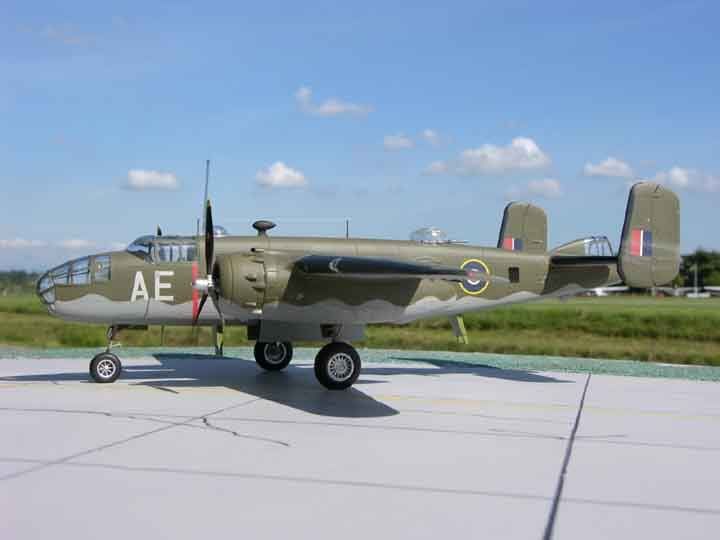
Barney

Re: RCAF History Forum
Moose. I've been following this thread since its inception. I want to thank for all of your posts and determination to keep it going. My dad was with 22 sqaudron at Rockliffe as an aero engine mechanic. He spent most of his flying time in Goose 926 and 941. I have a pile of picture I want/need to scan to contribute. It will take a while as I am dealing with health issues. When stronger, I'm happy to share.
This is just great stuff.
This is just great stuff.
-
Old Dog Flying
- Rank (9)

- Posts: 1259
- Joined: Sun Jul 27, 2008 5:18 pm
Re: RCAF History Forum
More ZBB model aircraft: 1;48 scale Hurricane Mk XII

Bolingbroke also in 1:48
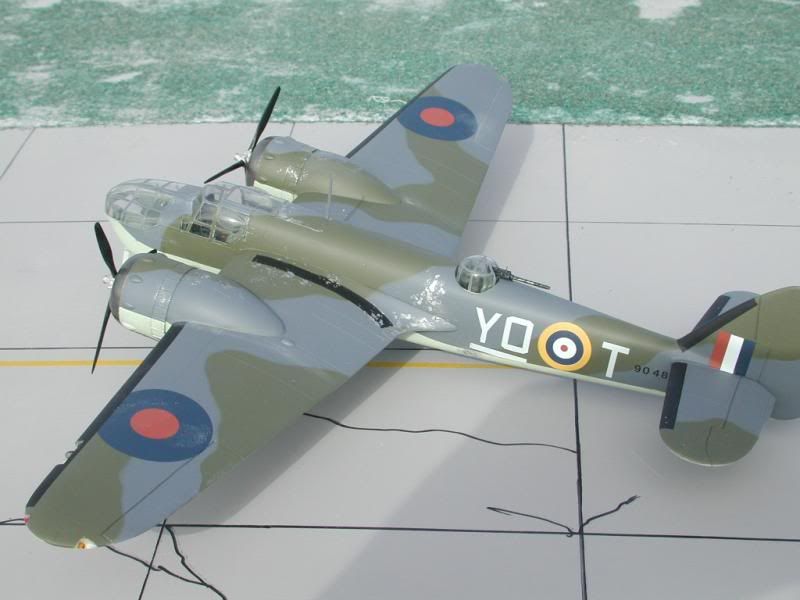

Bolingbroke also in 1:48

-
Old Dog Flying
- Rank (9)

- Posts: 1259
- Joined: Sun Jul 27, 2008 5:18 pm
Re: RCAF History Forum
I'm speechless. That's incredible.
941 is now parked in the Caribbean following an accident. 926 is wreck in the boneyard to Port Hardy.
Thabk you for sharing that with me.
Brian
941 is now parked in the Caribbean following an accident. 926 is wreck in the boneyard to Port Hardy.
Thabk you for sharing that with me.
Brian
-
Moose47
- Rank (9)

- Posts: 1348
- Joined: Sat Apr 19, 2008 2:45 pm
- Location: Home of Canada's Air Defence
Re: RCAF History Forum
G'day Brian
I think you meant to type No. 12 Squadron.
No. 12 Communications Squadron based at R.C.A.F. Station Rockcliffe, Ontario operated the following Grumman Gooses or is it Geese?
Grumman Goose
CF-BKE later R.C.A.F. s/n 924
CF-BTE later R.C.A.F. s/n 939
CF-BTF later R.C.A.F. s/n 940
CF-BQE later R.C.A.F. s/n 941
NC16912 later R.C.A.F. s/n 942
R.C.A.F. s/n 917
The port oleo broke while being moved at Ottawa on the 13th of February, 1940 causing the port wing to strike the ground. The aircraft was repaired. It later landed at the Toronto Island Airport on the 17th of May, 1940 with the gear retracted. The pilot had been distracted by a combination of foul WX and engine trouble. The aircraft was subsequently repaired,
R.C.A.F. s/n 924
The port oleo broke while being moved at Ottawa on the 21st of February, 1940 causing the port wing to strike the ground. The aircraft was repaired.
R.C.A.F. s/n 925
R.C.A.F. s/n 926
R.C.A.F. s/n 943
On the 20th of August, 1942, this aircraft got tossed around during a wind storm causing it to strike the following No. 12 Squadron aircraft: Goose s/n 944, Lockheed 12A s/n 7654, and Norseman Mk. IV s/n 2477, Repairs were carried out. A wing float was torn off during a glassy water landing at Lake. St. Gabriel on the 12th of August, 1943 causing the Goose to roll over on its back and sink. It was later recovered and repaired
Goose Mk. II
CF-BTE later R.C.A.F. s/n 939
R.C.A.F. s/n 383
R.C.A.F. s/n 386
R.C.A.F. s/n 390
This aircraft ran over a shoal while taking off from Leon Lake, Ontario on the 3rd of August. 1945, damaging the hull. The aircraft was repaired.
The attached photo is of Goose s/n 926.
Cheers...Chris
I think you meant to type No. 12 Squadron.
No. 12 Communications Squadron based at R.C.A.F. Station Rockcliffe, Ontario operated the following Grumman Gooses or is it Geese?
Grumman Goose
CF-BKE later R.C.A.F. s/n 924
CF-BTE later R.C.A.F. s/n 939
CF-BTF later R.C.A.F. s/n 940
CF-BQE later R.C.A.F. s/n 941
NC16912 later R.C.A.F. s/n 942
R.C.A.F. s/n 917
The port oleo broke while being moved at Ottawa on the 13th of February, 1940 causing the port wing to strike the ground. The aircraft was repaired. It later landed at the Toronto Island Airport on the 17th of May, 1940 with the gear retracted. The pilot had been distracted by a combination of foul WX and engine trouble. The aircraft was subsequently repaired,
R.C.A.F. s/n 924
The port oleo broke while being moved at Ottawa on the 21st of February, 1940 causing the port wing to strike the ground. The aircraft was repaired.
R.C.A.F. s/n 925
R.C.A.F. s/n 926
R.C.A.F. s/n 943
On the 20th of August, 1942, this aircraft got tossed around during a wind storm causing it to strike the following No. 12 Squadron aircraft: Goose s/n 944, Lockheed 12A s/n 7654, and Norseman Mk. IV s/n 2477, Repairs were carried out. A wing float was torn off during a glassy water landing at Lake. St. Gabriel on the 12th of August, 1943 causing the Goose to roll over on its back and sink. It was later recovered and repaired
Goose Mk. II
CF-BTE later R.C.A.F. s/n 939
R.C.A.F. s/n 383
R.C.A.F. s/n 386
R.C.A.F. s/n 390
This aircraft ran over a shoal while taking off from Leon Lake, Ontario on the 3rd of August. 1945, damaging the hull. The aircraft was repaired.
The attached photo is of Goose s/n 926.
Cheers...Chris
- Attachments
-
- Goose926.jpg (79 KiB) Viewed 6556 times
-
Old Dog Flying
- Rank (9)

- Posts: 1259
- Joined: Sun Jul 27, 2008 5:18 pm
Re: RCAF History Forum
A few photos of 5 OTU Boundary Bay during the Second World War. Initially CZBB was an RAF OTU but in 1944 it was turned over to the RCAF. A total of 192 crews were trained at Boundary Bay.
Photos from the RCAF
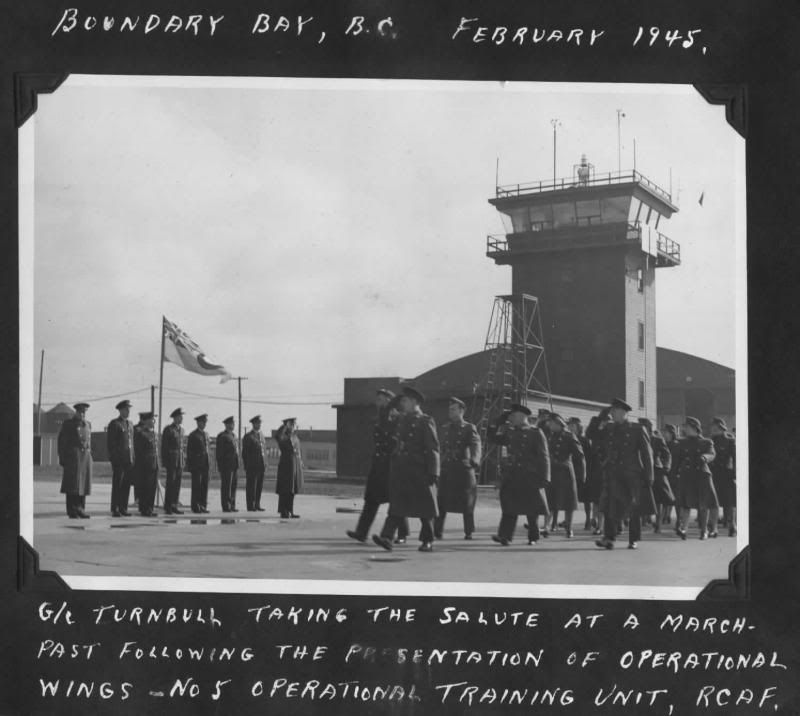
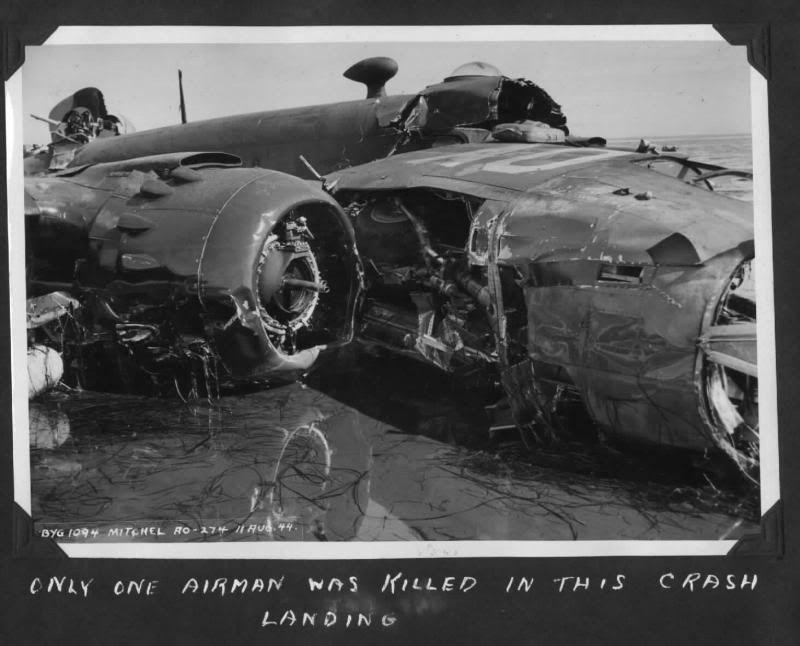
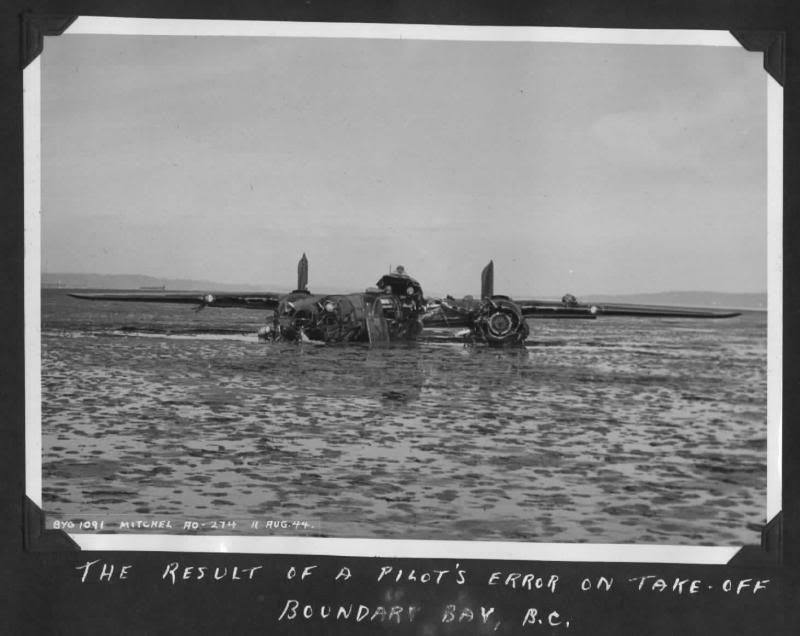
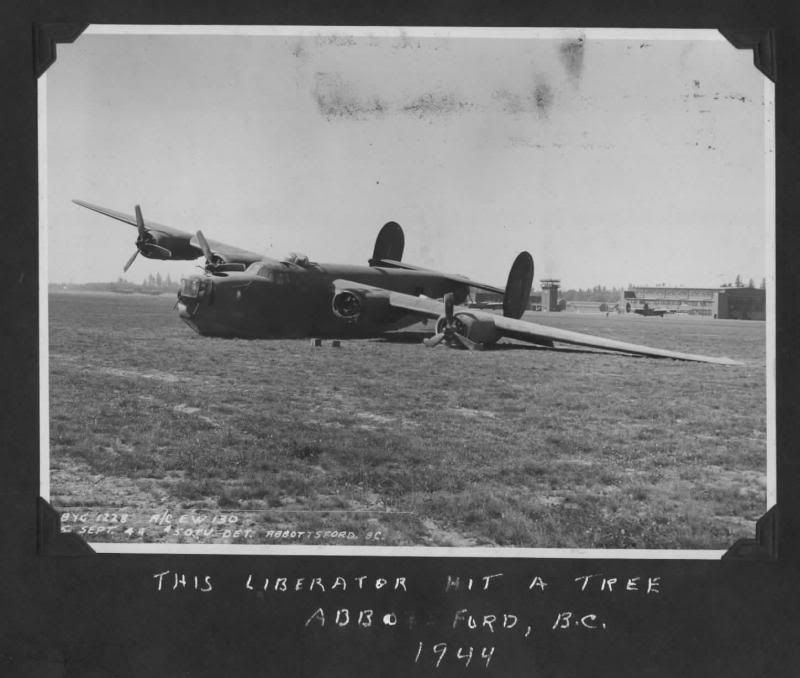
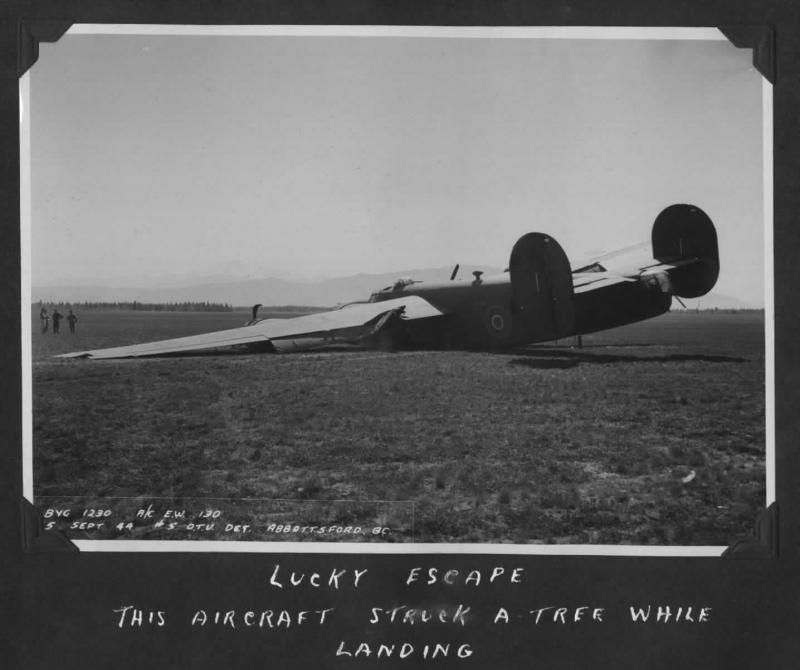
Photos from the RCAF






